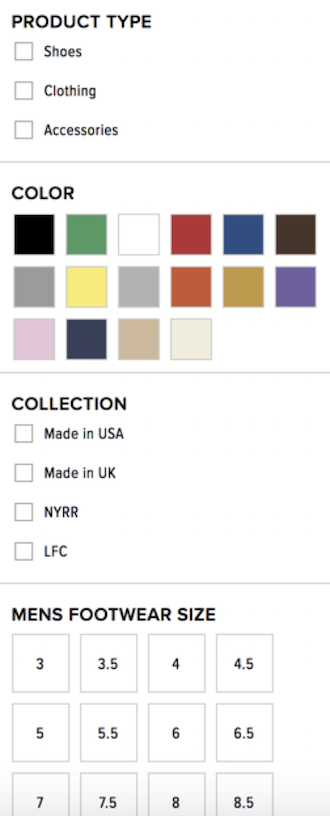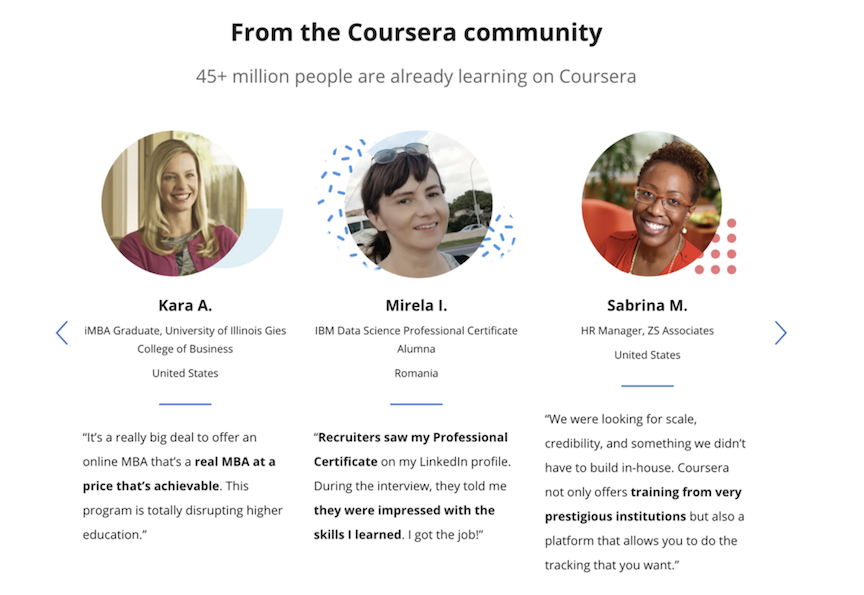-
 10 min. read
10 min. read
-
 Sarah Berry
Sarah Berry Web Marketing Consultant
Web Marketing Consultant
- Sarah Berry is a Google Analytics-certified Web Marketing Consultant at WebFX. She’s written over 400 articles on digital marketing, covering topics like SEO, CRO, and Amazon. When she isn’t polishing her Time Magazine Person of the Year Award, she’s spending time with her flock of ducks.
Are you happy with your ecommerce conversion rate? If not, it’s okay — only 22% of businesses are. Even if you’re somewhat happy with your conversion rate, it certainly wouldn’t hurt to improve it.
That’s why we put together this list of 11 ways to improve your ecommerce conversion rate. Whether you want users to make a purchase, subscribe to an email list, or engage with a chatbot, these website conversion tips will help you drive conversions and meet your goals. At WebFX, we have lots of experience with ecommerce conversion rate optimization.
We offer expert conversion rate optimization services, and we’ve generated more than $2.4 billion in revenue for our clients over the last five years. Contact us to learn more about our services, or keep reading for tips on how to improve your ecommerce conversion rate.
Partner with a team of ecommerce masters!
WebFX campaigns have delivered more than 14,936,451 ecommerce transactions in the last 5 years
Read the Case Studies

What is the average ecommerce conversion rate for 2021?
Wondering what a good ecommerce conversion rate for 2021 is?
Let’s take a look at some averages. In ecommerce, the average conversion rate — in terms of orders divided by site visits — is 3%, according to data compiled by Smart Insights. In other words, 3% of the users that visit an ecommerce site convert.
The average ecommerce conversion rate differs according to the types of goods the site sells. Ecommerce sites that sell gifts have an average conversion rate of 4.9%, while the consumer electronics sector has a rate of 1.4%. If you look at average website conversion rate by industry, ecommerce has a relatively low conversion rate compared to other sectors.
The professional and financial services industry, for example, has an average conversion rate of 10%. So, why does conversion rate differ greatly among industries? Numerous factors influence conversion rate, and each factor impacts industries differently.
Some of the potential factors include:
- Your industry
- The traffic source (e.g. organic search, PPC ads, email)
- The device the customer is using
- The user’s location
- The user’s interests
- And much more
When analyzing your conversion rate and comparing it to averages, it’s important to consider these various factors that affect conversion rates. Doing so will help you ensure your conversion rate is accurate and useful to your company.
How to improve your ecommerce conversion rate
So, how can you increase your ecommerce conversion rate? Here are some of the top tips for how to increase ecommerce sales and conversions.
1. Test out several calls to action (CTAs)
CTAs play a crucial role in ecommerce conversion rate optimization.
These bits of text, which typically come in the form of a button, guide users on how to proceed or encourage users to convert. For example, your CTA might say “Shop Now” or “Sign Up Today.” Here’s an example of a CTA on Nordstrom’s website that uses the “Shop Now” CTA. You can use free tools like Google Optimize to run tests that compare several CTAs. For example, you could run a test that shows some customers a button that says, “Shop Now” and others a button that says, “Get Yours Today.” The test will tell you which button performed best.
You can use free tools like Google Optimize to run tests that compare several CTAs. For example, you could run a test that shows some customers a button that says, “Shop Now” and others a button that says, “Get Yours Today.” The test will tell you which button performed best.
While testing out several CTAs is useful, make sure visitors only see one at a time. Having multiple CTAs can confuse the visitor or make them feel unsure of which button to click. This “paradox of choice” may lead to them not clicking any CTAs at all.
2. Offer a personalized experience
Software, such as MarketingCloudFX, enables you to personalize your site content for each visitor.
You can show visitors different greeting, CTAs, and offers based on their demographics, on-site behavior, and referring site. Nearly 60% of shoppers say that personalization has a noticeable effect on their purchase decisions. Personalizing your site content may help increase your ecommerce sales.
For example, if someone previously visited your site and browsed men’s shoes, the next time they visited your site, you could show them more content about men’s shoes. You could also serve them an ad with a special offer on men’s shoes. Because they’re already interested in men’s shoes, content and offers related to them are more likely to capture and keep their attention, potentially leading to a conversion.
Read: How to increase online sales
3. Simplify your checkout process
A long and complicated checkout process may make shoppers more likely to abandon their shopping carts.
Keep your checkout process as simple as possible and only collect the necessary information. We rounded up other checkout process optimization best practices that you can emulate.
Collecting the necessary data from your customers is also important for other types of conversions. For email newsletter signups, for example, only require users to provide the essential information, perhaps just their name and email address.
4. Make your site easy to navigate
If customers can’t find what they’re looking for, they can’t make a purchase.
When customers encounter confusing site navigation, they may get frustrated or intimidated and click away. Make your site navigation as intuitive and straightforward as possible. A good navigation includes:
- Clear categories
- User-friendly navigation
- Filtering capabilities
- A search function
- And more
Check out the product navigation on New Balance’s website.  Shoppers can filter search results by multiple categories at once, including product type, product color, size, and more, allowing them to find the product they want quickly. For example, you could filter the results to show only red shoes that are available in size 10 and made in the U.S.
Shoppers can filter search results by multiple categories at once, including product type, product color, size, and more, allowing them to find the product they want quickly. For example, you could filter the results to show only red shoes that are available in size 10 and made in the U.S.
5. Improve your page speed
Users expect websites to load in three seconds or less.
If your site doesn’t load quickly, prospects may leave and go to a competitor’s site. Decreasing your load time keeps visitors on your page and can increase your ecommerce conversion rate. When tax software company Intuit experimented with reducing their site’s load time, they found that a decrease of just 2-5 seconds resulted in a 1% increase in conversions.
You can use Google’s PageSpeed Insights tool to test your site’s speed and get recommendations for improving it. If you’re not sure how to improve your page speed or you want to boost your speed without the effort, consider professional page speed optimization services.
6. Analyze how users interact with your site
Analyzing how users interact with your website can reveal opportunities for improvement and give you insights into how to improve your ecommerce conversion rate. For instance, in Google Analytics, under Behavior, you can see which pages people most often exit your site from, which can help you pinpoint low-performing pages.
If people frequently exit from a particular page before converting, you can modify the page to try to increase your ecommerce conversion rate. Under Conversions, you can explore data about shopping behavior, checkout behavior, and more. These reports give you insight into how users are moving through your shopping and checkout processes.
You can use these insights to improve your processes. For example, if many customers are abandoning their orders at the billing and shipping stage, you could try making your billing and shipping forms more user-friendly.
7. Make your site mobile-friendly
If you don’t design your site for mobile devices, you may miss out on a significant number of conversions. Today, over 40% of online transactions occur on mobile devices, so making your site mobile-friendly may substantially increase your ecommerce sales.
To make your site mobile-friendly, use responsive design, which enables your site to adjust to fit any device. Responsive design will help you create a better experience for your audience, which will lead to more sales for your ecommerce business. You can also test how mobile-friendly your site is with Google Mobile-Friendly Test tool.
Simply enter your URL, and the tool will:
- Tell you if your site is mobile-friendly
- Show you a screenshot of what your site looks like on mobile devices
- Give you a list of any mobile usability issues
8. Use high-quality images and videos
Including high-quality images and videos on your site can help get visitors’ attention and encourage them to stay on your site longer. In fact, content with visuals gets 94% more views than content with just text, and videos increase conversions by 86%. High-quality images and videos of your products can also help grab users’ attention and get them to learn more about your product.
Apple, for example, frequently uses large, eye-catching images on their site. The image below features at the top of the site’s main iPhone page. This high-quality image draws users in and gets them to learn more about the product.
This high-quality image draws users in and gets them to learn more about the product.
9. Include social proof
According to a Nielsen study, 84% of shoppers trust recommendations from family, friends, and peers more than any other type of marketing. These same shoppers trust online reviews just as much as they trust recommendations from people they know.
That’s why including social proof on your site can be so effective. This social proof can come in the form of reviews, testimonials, user-generated social media content, and celebrity endorsements. Coursera, a site that offers online courses on a variety of topics, has a social proof section on their homepage. It tells you how many people are using Coursera and includes testimonials from users. These testimonials provide Coursera’s visitors with valuable insight into the company’s offerings.
These testimonials provide Coursera’s visitors with valuable insight into the company’s offerings.
10. Showcase your return policy
Include basic information about your return or guarantee policy on pages where users may be considering a purchase.
Doing so can give shoppers the confidence they need to make a purchase, as it reduces their risk of being afraid to purchase a product if that product ends up not meeting their needs. Briefly highlight your return policy or guarantee on relevant pages and link to your full policy, which should be clear and easy to read. Also, aim to make the return process as easy as possible for customers.
11. Examine your Internet marketing strategy
If your digital marketing strategy isn’t bringing enough traffic to your site or isn’t bringing the right kind of traffic, you’re not going to get the conversions you’re looking for.
A marketing campaign that isn’t targeted to the right people might bring users to your site who aren’t actually interested in your products, for example. If your site isn’t ranking well in search results for relevant terms, users may not find your site at all. To make sure your online marketing strategy is effectively driving conversions, check elements such as:
- Whether the keywords you’re targeting on your site are the ones prospects are searching
- Whether your ads are targeting the users who are most likely to convert
- Whether the content you’re creating is aligned with your conversion goals
- Whether your social media posts address topics that interest your target audience and lead to engagement
A digital marketing strategy tailored to your business’s needs from an experienced digital marketing agency like WebFX can help you get the traffic — and conversions — you need.
Increase your ecommerce conversion rate with WebFX
Want to improve your conversion rate and increase your ecommerce sales? WebFX can help. We’ve managed more than 11.6 million transactions and generated $2.4 billion in revenue for our clients over the last five years.
We offer expert conversion rate optimization services, which include conversion rate testing, headline copywriting, regular reporting, and much more. As a full-service digital marketing agency, we also offer numerous other Internet marketing services, including search engine optimization (SEO), pay-per-click (PPC) advertising management, and email marketing management to help increase the quantity and quality of traffic to your site. To learn more, contact us online or call us today at 888-601-5359 to speak with a strategist.
-
 Sarah Berry is a Google Analytics-certified Web Marketing Consultant at WebFX. She’s written over 400 articles on digital marketing, covering topics like SEO, CRO, and Amazon. When she isn’t polishing her Time Magazine Person of the Year Award, she’s spending time with her flock of ducks.
Sarah Berry is a Google Analytics-certified Web Marketing Consultant at WebFX. She’s written over 400 articles on digital marketing, covering topics like SEO, CRO, and Amazon. When she isn’t polishing her Time Magazine Person of the Year Award, she’s spending time with her flock of ducks. -

WebFX is a full-service marketing agency with 1,100+ client reviews and a 4.9-star rating on Clutch! Find out how our expert team and revenue-accelerating tech can drive results for you! Learn more
Try our free Marketing Calculator
Craft a tailored online marketing strategy! Utilize our free Internet marketing calculator for a custom plan based on your location, reach, timeframe, and budget.
Plan Your Marketing Budget

Maximize Your Marketing ROI
Claim your free eBook packed with proven strategies to boost your marketing efforts.
Get the GuideTry our free Marketing Calculator
Craft a tailored online marketing strategy! Utilize our free Internet marketing calculator for a custom plan based on your location, reach, timeframe, and budget.
Plan Your Marketing Budget




